Metal stamping

ChinaCustomStamping is a professional manufacturer in China, offering a full range of custom metal stamping solutions, including progressive metal stamping, single-hit dies, prototype metal stamping, and value-added assembly services. Our high-quality manufacturing capabilities exceed expectations and help you gain a competitive edge in the market.
Custom Metal stamping
We work with a wide variety of raw materials, including aluminum, brass, copper, bronze, carbon steel, stainless steel, and exotic metals. Our press capacities range from 5 to 1,000 tons, ensuring precision and versatility. Every part undergoes rigorous inspection using advanced vision systems, optical comparators, CMM equipment, and functional gauges. All tooling dies are designed and manufactured in-house for superior quality control.
Our expert team manages every stage of your project—from design to final delivery. We don’t just handle your metal stamping needs; we provide end-to-end solutions tailored to your specific requirements.
With years of industry expertise, we continuously refine our skills to deliver cost-effective metal stamping solutions. Innovation is at the core of our mission, making us a trusted leader in metal stamping manufacturing.
The Features of Metal Stamping
Advantages
Metal stamping relies on precision dies and advanced machinery, offering several key benefits over other metalworking processes:
- Energy-efficient & material-saving – Reduces waste and lowers production costs.
- Consistent quality & high precision – Ensures tight tolerances and repeatability.
- Complex geometries & lightweight parts – Capable of producing thin-walled, rigid, and intricately shaped components.
- High productivity & automation-friendly – Streamlines operations for faster turnaround times.
Limitations
While highly efficient, metal stamping does have some challenges, primarily noise and vibration during production. These issues are often linked to older stamping equipment rather than the process itself. Thanks to technological advancements, modern solutions have significantly minimized these drawbacks.
The cross-section of metal stamping part

It can be distinctly divided into four parts: the rollover, the burnished zone (shear zone), the fractured zone, and the burr.
1. Rollover
The rollover (R) occurs when the material near the cutting edge deforms (bending and stretching) during the stamping process. Key factors affecting rollover:
- Material plasticity – More ductile materials result in larger rollover.
- Punch-die clearance – Greater clearance increases rollover size.
2. Burnished Zone (Shear Zone)
The burnished zone is a smooth, vertical section formed by plastic deformation as the punch and die compress the material after penetration. Characteristics:
- Typically 1/3 to 1/2 of the sheet thickness in conventional stamping.
- Wider in more ductile materials due to enhanced plastic deformation.
3. Fractured Zone
The fractured zone is a rough, angled surface created by main crack propagation.
- Brittle materials exhibit more severe tearing, increasing the fractured zone’s proportion.
4. Burr
Burrs form when micro-cracks develop near the cutting edge and are elongated as the punch advances. Key influence:
- Smaller stamping clearance = reduced burr height
Stamping Clearance

The dimensional difference between the punch and die cutting edges is known as stamping clearance. This crucial parameter plays a vital role in multiple aspects of the stamping process, including:
- The final quality of stamped components
- The operational lifespan of the mold
- The required stamping forces (including stripping and ejection forces)
- Overall production efficiency
Effect of Clearance on Part Quality
The evaluation of stamped part quality focuses on three essential criteria:
- The condition and finish of cut surfaces
- The precision of dimensional measurements
- The degree of surface flatness
While numerous variables affect these quality indicators, clearance stands out as one of the most significant contributing factors.
Effect of Clearance on Cut Surface Quality
The integrity of a stamped part’s cut surface is characterized by four key attributes:
- The extent of rollover deformation
- The percentage of burnished zone (shear zone) in relation to material thickness
- The angular characteristics of the fractured zone
- The presence and severity of burrs
When optimal clearance is maintained:
- Shear cracks originating from both upper and lower cutting edges align precisely
- The burnished zone constitutes approximately 30-50% of the material thickness
- Rollover deformation, burr formation, and fracture angles are minimized
- The resulting components consistently meet standard industrial requirements
Effect of Clearance on Dimensional Accuracy
Dimensional accuracy quantifies the variance between a part’s actual measurements and its specified nominal dimensions, with smaller deviations indicating higher precision. This accuracy is primarily determined by two critical elements:
- The inherent manufacturing tolerances of the die set
- The dimensional variation occurring during the stamping operation
Key factors influencing dimensional accuracy include:
✔ Materials with greater relative thickness exhibit reduced elastic deformation, yielding improved accuracy
✔ Components with smaller dimensions and simpler geometries achieve higher precision due to:
- More consistent clearance maintenance
- Reduced part warping
- Minimized elastic deformation effects
Effect of Clearance on Mold Life
Clearance significantly affects die durability, with improper settings accelerating tool failure. The three predominant failure modes in stamping dies – all directly influenced by clearance – are:
- Progressive wear of cutting edges
- Localized edge chipping
- Structural cracking in die cavities
Proper clearance optimization substantially extends tool service life by mitigating these failure mechanisms while maintaining optimal part quality.
Metal Stamping: Precision Manufacturing for High-Volume Production

Metal stamping is a highly efficient manufacturing process that transforms metal sheets into precise components using a stamping press and specialized tooling. In this process, a metal sheet is placed into a press containing a custom-designed die, which applies controlled pressure to cut, bend, or form the material into the desired shape. This method is particularly valued for its ability to produce large quantities of identical parts with exceptional dimensional accuracy and consistency.
The metal stamping process serves as a cornerstone manufacturing solution across multiple industries, including automotive, aerospace, electronics, and appliance manufacturing. Typical applications include production of:
- Structural brackets
- Metal panels
- Protective enclosures
- Various mechanical components
Key Advantages of Metal Stamping:
- Precision Manufacturing: Capable of maintaining tight tolerances (±0.001″) for high-precision applications
- Mass Production Efficiency: Ideal for high-volume production runs with consistent quality
- Material Optimization: Minimizes waste through efficient nesting and material utilization
- Cost-Effectiveness: Reduces per-unit costs for large quantity orders
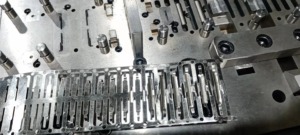
Stamping Process Variations:
The stamping process offers multiple approaches to suit different production requirements:
- Single Hit Dies: Traditional method using multiple die sets for sequential operations
- Progressive Die Stamping: Advanced solution for high-volume production that combines multiple operations into a single die, offering:
- Significant cost reduction
- Increased production speed
- Improved process efficiency
For manufacturers prioritizing production efficiency and cost control, progressive die stamping has become the preferred solution for large quantity orders, delivering superior economies of scale while maintaining strict quality standards.
Metal Stamping Processes Overview
As a leading metal stamping manufacturer, ChinaCustomStamping offers the following key processes,
-
Blanking & Protection film
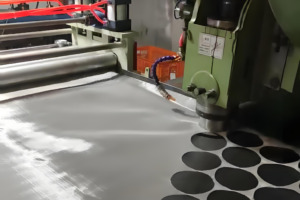


Blanking is a metal stamping process that involves cutting a flat shape out of a metal sheet. In blanking, a specially designed die and punch set is used to cut the desired shape from the metal sheet, leaving behind the desired part known as a “blank.” This process is commonly used to create flat components such as washers, discs, and other simple shapes with precise dimensions. Blanking are often used as raw materials for subsequent forming processes or as standalone parts in various industries.
We trust that many customer are facing the problem that small dent, scratch on the surface of your stamping parts. In order to solve this problem, our worker stick the protection film on the metal sheet during the blanking. After stamping, we just have to peel off the film and the surface can be protected very nicely.
-
Piercing



Piercing is a metalworking process that involves creating holes in a metal sheet or part using a specialized tool called a piercing punch. The piercing punch is forced through the metal sheet, removing a portion of material and creating a hole with a specific diameter and shape. Piercing is commonly used in metal stamping process to create openings for fasteners, connections, or ventilation in sheet metal components. It enables the production of parts with accurate hole placement, clean edges, and high efficiency in mass production processes.
-
Restriking
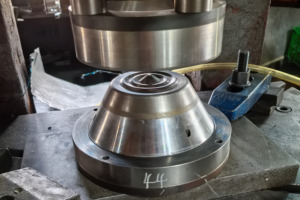
Restriking is a metal stamping process that involves reusing a previously stamped part or blank to create a new component. In restriking, the existing part is placed back into the stamping press and subjected to additional forming operations using specialized tooling. This process allows manufacturers to modify or reshape existing parts without starting from scratch, reducing material waste and production time. Restriking is often used in situations where design changes or adjustments are needed after the initial stamping operation.
-
Forming

The forming process is to directly duplicate and form the workblank or semi-finished workpiece according to the shape of convex and concave dies, and the die with local plastic deformation produced by the material itself is called forming die. The forming process can be divided into hole turning, expansion, necking, flaring, fluctuation forming and sizing, etc
-
Flanging

Flanging is a metal stamping process that involves manipulating a metal sheet along its edge to create a curved or angled flange. This process is commonly used in metal fabrication to add strength, stiffness, or attachment points to a component. It can be done using specialized tools such as flanging dies or machines to achieve the desired shape and dimensions. It is a common technique in industries like automotive, aerospace, and HVAC for creating components with specific design requirements.
-
Trimming
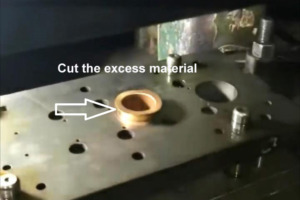
Trimming is a stamping process that involves cutting excess material from a metal part or component to achieve the final desired shape and size. It is often done after the initial stamping or forming process to remove any unwanted edges, burrs, or excess material left behind. Trimming can be performed using various tools such as shears, dies, or laser cutters to ensure precision and accuracy in the final product. This process is crucial in metal stamping and fabrication to produce high-quality components with tight tolerances.
- and so on
Stamping Dies
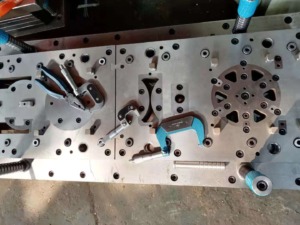
The tooling used in stamping is called stamping die, which is called die for short. Die is a special tool for batch processing of material (metal or non metal) into required blanking parts. Punching die is very important in stamping. Without qualified die, batch stamping is difficult to carry out. Without advanced dies, the advanced stamping process can’t be realized. Stamping process and die, stamping equipment and stamping material constitute the three elements of stamping, only by the combination of them can get the stamping parts at good quality and effective cost.
Types of metal stamping
To achieve high-quality finished parts, various metal stamping techniques are utilized. There are three primary types of metal stamping: Progressive die stamping, Deep draw stamping, and Fourslide stamping. Each of these types employs unique methods to produce precision-made components.
Progressive die stamping
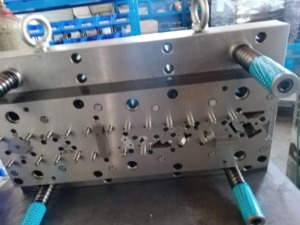
Progressive stamping, also known as prog die stamping, involves feeding a strip of metal through a press that has multiple stations. As the metal passes through, each station performs a specific task, such as forming, punching, bending, or cutting the metal.
For projects that involve complex parts, progressive stamping typically requires the use of multiple stations or stages. This process offers several advantages, including quick turnaround times and the ability to produce repeated, uniform pieces. Additionally, it has the lowest labor cost per stamping type, making it an efficient and cost-effective choice for many manufacturing needs.
Deep Draw Stamping

Deep drawing is a metal stamping technique that involves using a punch to force a blank material into a die. This method is particularly effective for creating parts with extreme depths and complex shapes, which are often required in the automotive and aerospace industries. Compared to other stamping processes, deep drawing uses less raw material and is highly efficient for producing large volumes of less-complicated parts.
The picture we show above is our common deep drawing parts.
Fourslide Stamping
Fourslide stamping is a metalworking technique that facilitates the production of intricate components. It involves the simultaneous use of four tools to bend the metal into the desired shape. Although it may not achieve the same level of uniformity as progressive stamping, fourslide stamping offers greater ease in modifying or adapting the design when a project necessitates various parts with different bending requirements.
Short-Run Stamping
Short-run metal stamping involves minimal upfront tooling costs, making it an excellent choice for prototypes or small-scale projects. Once the blank is produced, manufacturers utilize a mix of custom tooling components and die inserts to perform operations such as bending, punching, or drilling. While the specialized forming processes and limited production quantities may lead to a higher cost per piece, the elimination of tooling expenses often makes short-run stamping a cost-effective option for many projects, particularly those needing quick turnaround times.
Our Metal Stamping Capabilities
ChinaCustomStamping is a professional metal stamping manufacturer with extensive production capabilities to meet diverse customer needs. Below is an overview of our stamping expertise and equipment.
Equipment & Technology
Equipment selection is critical to ensuring optimal stamping performance, product quality, and cost efficiency. Our facility features a comprehensive range of advanced stamping machines, including:
- CNC Stamping/Punching Machines – For high-precision sheet metal fabrication
- Crank Presses – Reliable mechanical presses for standard stamping operations
- High-Speed Presses – Ideal for mass production with superior efficiency
- CNC Bending Machines – Ensuring accurate and repeatable forming
- CNC Cutting Machines – Delivering clean, precise cuts
- 5~1000 Ton Punching & Pressing Machines – Covering a wide range of tonnage requirements
- Welding Machines (Arc-Argon, Spot Welding, etc.) – For strong, durable joints
- Polishing Machines (Buff, Vibration, Electro-Polishing) – Enhancing surface finish quality
Our presses are categorized into two main types:
- Mechanical Presses – The most common choice for high-speed, precision stamping
- Hydraulic Presses – Best suited for deep drawing and heavy-duty forming
With advancements in stamping technology, we also utilize high-speed presses and CNC turret punch presses to meet modern manufacturing demands.
ChinaCustomStamping ensures high-quality production through state-of-the-art equipment, optimized processes, and strict quality control. Contact us for customized metal stamping solutions tailored to your requirements.
Material Selection for Metal Stamping & Deep Drawing
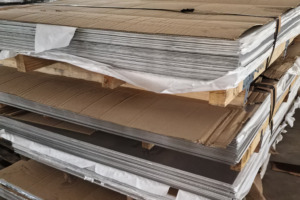
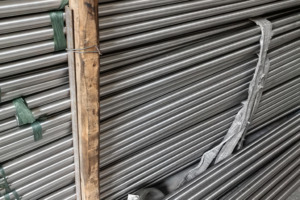
Material selection plays a critical role in metal stamping and deep drawing processes, directly impacting:
- Process design optimization
- Finished part quality and durability
- Production efficiency
- Overall manufacturing costs
Key Material Considerations:
We prioritize selecting materials that meet both functional requirements and manufacturing feasibility. Our expertise covers a comprehensive range of metals, including:
Stainless Steels:
316, 304, 302, 430, 201 series
Copper & Alloys:
Pure copper (C11000, C12000)
Copper grades (T1, T2, T3)
Phosphor bronze
Aluminum Alloys:
5052, 6061, 1100
L-series (L2, L3, L5, L7)
Brass Alloys:
H65, H60, H75
Steel Varieties:
Carbon steels (#50, #55, #60, #65)
Cold rolled steels (Q235, Q245)
Spring steels (60Si2Mn, 60Si2MnA, 65Mn, T8A)
Galvanized steel
Specialty Metals:
Titanium (TA2, TA3, TA5)
Silver
Other custom materials (available upon request)
Our material selection process ensures optimal performance for your specific application while maintaining cost-effectiveness. We can advise on the best material choice based on your component’s functional requirements and production parameters.
Surface treatment
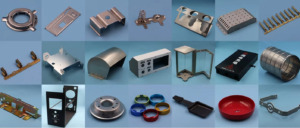
By our many years experiences in metal parts, we can handle almost all surface finish in current industry, Such as
- Hot galvanized,
- Polishing,buff polish ,mirror or bright polish ,satin polish,barrel polish
- Plating ,chrome,zinc,nickel, brass
- Powder coating,
- Anodize,
- Painting,
- Shot blast,
- Sand blasting,
- Other customized finish
Thickness
Due to our full experience and advanced equipment, we can produce with all regular thickness material
- 0.2mm ~8.0mm
- Other thickness to be confirmed with us
Inspection
From raw material to final shipping products, we inspect and control the quality nicely .We understand quality is the only way to get survival under fierce competition.
- IQC, IPQC,FQC,QA
- ISO 9001
- 6S
Also, we have a lot of inspection tools to make sure the every project of customer to be made in good quality.

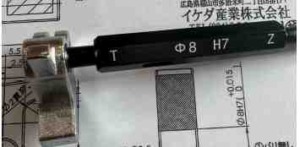
Metal Stamping Range:
- Aluminum Stampings
- Automotive Stampings
- Precision Metal Stamping
- Fourslide and Multislide Stampings
- Stainless Steel Stampings
- Long Run, High Speed Stamping
- Progressive Die Stampings
- Transfer stamping
- Fine Blanking
- Electronic Stamping
Our Metal Stamping Production Process
1. Tooling (Mold) design and Manufacture

2. Manufacture the parts by our Stamping Machine.
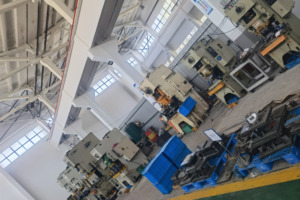
3. Riveting, Welding or Screw tap according to Customer’s require.
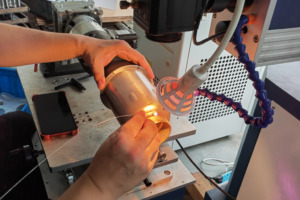
4. After finish manufacture process we will test the parts by the Image measurement instrument, Caliper, Angel Gage etc.
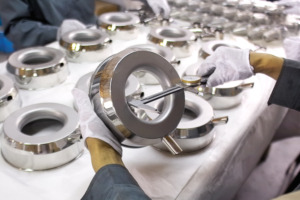
5. After make sure all the dimension can reach customer’s require, we will make the surface treatment process.
6. After finish surface treatment we will testing all the parts by worker so that we can make sure the parts which we sell is 100% qualified.
7. After finish testing we will pack the parts by Vacuum Package Machine.



